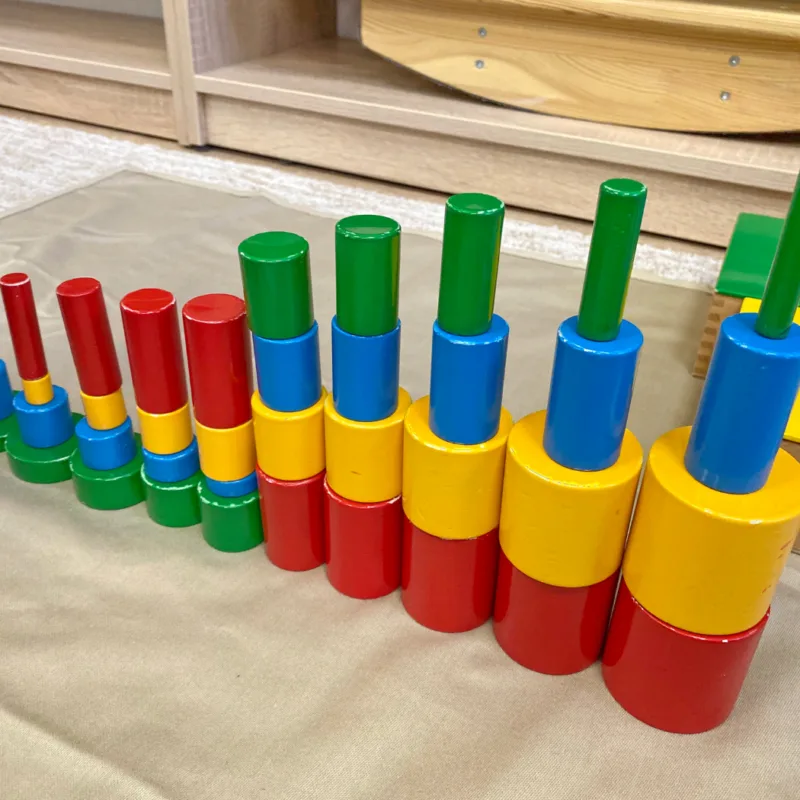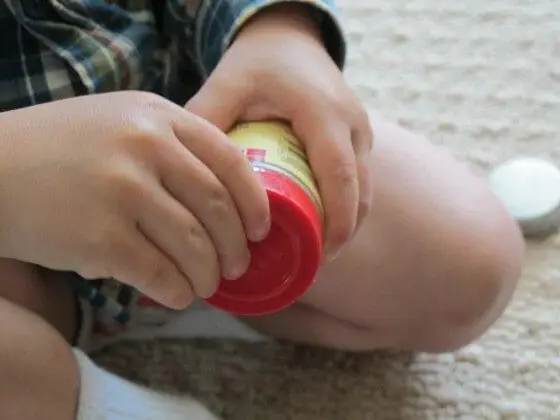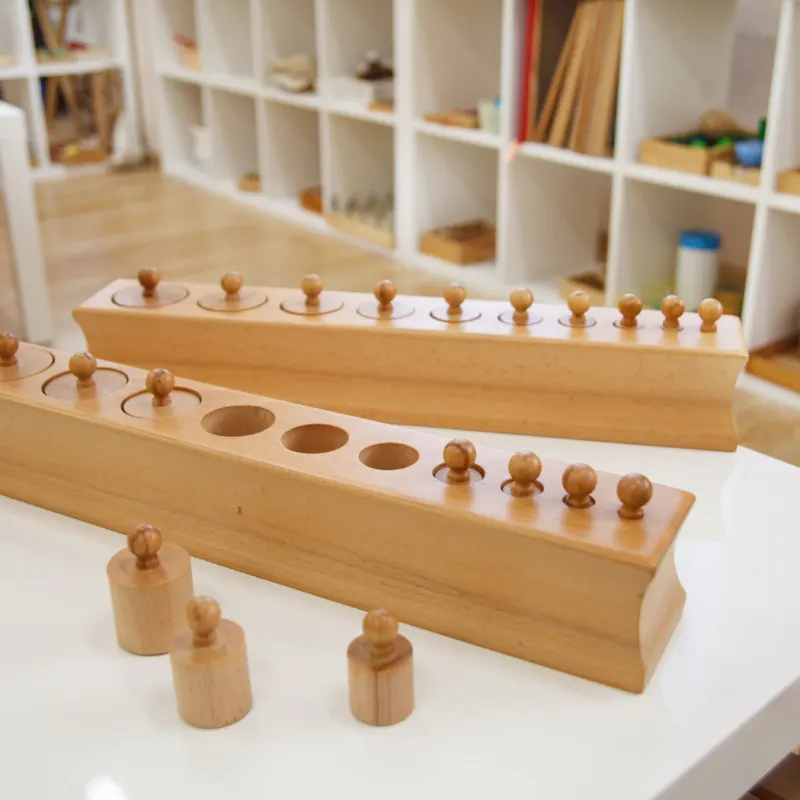New to Montessori? This article includes information on the sensorial area of the classroom. I go over sensorial materials, sensorial philosophy, and the sensorial lesson sequence.
Montessori emphasized the child’s ability to develop in his own time. In other words, to reach his potential on his own when given the freedom and a prepared environment. This respect Montessori bestowed on a child drew me to philosophy. She placed priority on the child and his natural development.
What is Sensorial?

By believing in the child, she encouraged and motivated children. Furthermore, she opened the eyes of teachers and parents. As Montessori saw it, the first goal of a child's development is to cater to the child's whole self.
Moreover, she viewed a child's development as far more significant than academic achievement. In other words, Dr. Montessori focused on a child's emotional and social well-being, including the development of self-esteem and confidence.

What is the Montessori Sensorial Theory?
What is Sensorial in Montessori? In Montessori education, the term “Sensorial” refers to a specific area of the curriculum that focuses on the development and refinement of a child's senses.
Dr. Maria Montessori, the founder of the Montessori educational approach, recognized that young children learn best through direct experiences and interactions with their environment.
The Sensorial materials and activities are carefully designed to stimulate and enhance the child's senses, leading to deeper understanding and cognitive development.
The Sensorial area in a Montessori classroom typically includes a wide range of materials that isolate specific sensory qualities such as size, shape, color, texture, weight, sound, smell, taste, and temperature.
Through working with these materials, children are encouraged to observe, compare, and contrast sensory impressions. This process allows them to sharpen their senses, make finer discriminations, and become more attuned to the world around them.
Key Goals and Benefits of the Sensorial Area in Montessori Education
- Refining the senses: Sensorial materials help children become more sensitive and perceptive to the various stimuli in their environment. This heightened awareness lays the foundation for later academic learning.
- Order and classification: The materials are designed with built-in control of error, encouraging children to classify and order sensory impressions accurately. This aids in the development of logical thinking and organization.
- Language development: As children work with the Sensorial materials, they are encouraged to express and communicate their observations and experiences, leading to language development and vocabulary enrichment.
- Preparation for academic subjects: Sensorial experiences serve as crucial preparation for later academic work, particularly in mathematics, geometry, and science, where precise observation and discrimination skills are required.
- Indirect preparation for writing: Working with various shapes and patterns through the Sensorial materials indirectly prepares the hand for later writing skills.
- Cultivating concentration and focus: The engaging and purposeful nature of Sensorial materials helps children develop concentration and deep focus, essential for meaningful learning experiences.
- Appreciation of beauty: Montessori Sensorial materials are often aesthetically pleasing and designed to appeal to a child's sense of beauty and order, fostering an appreciation for aesthetics and attention to detail.
It's important to note that the Sensorial area in a Montessori classroom is not just about developing the physical senses but also about nurturing the whole child's sensory perception, cognitive abilities, and emotional growth.
By providing a rich and stimulating environment, Montessori educators aim to support children in their natural development and lay a solid foundation for lifelong learning.
Montessori Sensorial Area
Montessori’s philosophy centers on whole child development. It also depends a great deal on the role of the teacher and a Prepared Environment.
Within a prepared environment, the teacher’s main job is to observe the child as he moves about with independence and liberty within the classroom. She must also know when to intervene to guide the child.

Role of Teachers and Parents in Montessori
Parents and teachers aid children but should only as guides, observers, and careful preparers of the environment. By giving the child liberty to move about the classroom with his natural desire to learn, the child learns at his own pace of development and maintains intrigue with the variety of materials available to him across subject areas and levels of difficulty.
Too often, adults interfere in solving a problem. Yet, the child needs guidance to help him stay within the parameters of his development. When given the opportunity, a child will focus and concentrate when working with the materials.

How to Teach Montessori Sensorial
Montessori wrote extensively about the spiritual journey and self-awareness that a teacher must follow and experience to be effective. My jaw dropped when I read that she views teachers as scientists needing to understand the psychology of children to understand a child's development.
That observation makes so much sense to me, yet I had never seen it written down. This fact alone drives the way an adult should teach and parent children.

“Our sensorial material provides a kind of guide to observation, for it classifies the impressions that each sense can receive: the colors, notes, noises, forms and sizes, touch-sensations, odors and tastes. This undoubtedly is also a form of culture, for it leads us to pay attention both to ourselves and to our surroundings.”
Dr. Maria Montessori, The Absorbent Mind
Once the teacher trains on the method and prepares spiritually to direct a class, she focuses on giving lessons and introducing the child to the materials. From there, the child leads his learning to experience with his own “hands” with “control of error” built into the works to enable auto-education.

The Guide & Sensorial Education
The teacher observes the child and knows when to intervene to direct the child back to an activity that suits his development. If the child is not treating material properly, the teacher will redirect the child to end that work (perhaps he was not ready to complete that work) or to give another lesson.
The child learns respect through these experiences. The role of a Montessori teacher is carefully orchestrating observation, spirituality, and preparation.
Montessori's Prepared Environment
As I mentioned above, in addition to the training she put forth with Montessori teachers, Maria implemented the Montessori method through a carefully prepared environment.
The environment should be a place that “nourishes the child” by not only meeting the needs for auto-education, which is required for a child to develop at his own pace but also by allowing the child’s unique personality and developmental path to reveal itself naturally.
It is important to note that Montessori did not view the classroom as a replacement for life but as a means to reach “the potential life within him visible.” {Montessori: A Modern Approach}
The teacher and the assistant carefully prepare the classroom environment for children ages 2.5-6. The mixed-age classroom is a critical aspect of the Montessori method. Children develop at different paces.
Mixed-age classrooms also provide built-in peer-to-peer teaching and role models for younger children. Older children take on the responsibility of demonstrating to younger children their knowledge.

Montessori Sensorial Materials
All Montessori materials are high quality and ascetically pleasing to the eye. They are simple and neat. There is a great sense of order in the presentation of the materials on the shelf and in the layout of the classroom in designated areas for Practical Life, Sensorial, Culture, Geography, Math, and so on.
Furthermore, every material in the Montessori classroom contains a “control of error,” the ability for the child to self-correct and for the teacher to stand back to observe and then guide when necessary. “
This self-correction leads the child to concentrate on the dimension differences and compare the various pieces.” [Montessori: A Modern Approach]
Sensorial: Education of the Senses
“It is necessary to begin the education of the senses in the formative period, if we wish to perfect this sense development with the education which is to follow. The education of the senses should be begun methodically in infancy, and should continue during the entire period of instruction which is to prepare the individual for life in society.”
Dr. Maria Montessori
Dr. Montessori believed that educating the senses preceded intellectual development. A child’s education of the senses begins at birth. He takes impressions of his world through his senses. Around 2.5 years old, he enters a sensitive period for organizing these impressions. Much like the alphabet organizes language, the sensorial work organizes these impressions.
“…the function of the sensorial materials is not to present the child with new impressions (of size, shape, color and so forth) but to bring order and system into the myriad impressions that he has already received and is still receiving.”
Dr. Maria Montessori
Montessori created materials based on empirical observations of children. She carefully took each of the senses and thought about how best she could help the children to clarify and expand their existing experiences.
Montessori focused on “systems of objects that share a definite quality, such as color, shape, dimension.” She set forth with preparing the environment that allowed a child to interact specifically with a material or a “quality.”
Isolation of Quality
Each group of objects represents the same quality but to different degrees. Each material emphasizes one particular quality by eliminating or minimizing other differences.
So there is consequently a common but gradual distinction between the various objects and, when this is possible, one that is mathematically fixed, like the Pink Tower and the decimal system.
Aims include developing concentration, attention, or visual discrimination. Indirect aims include math and, reading & writing. Works are completed left to right and top to bottom in preparation for these later skills to develop. Furthermore, new language such as “largest, smallest, heavier, rough, smooth….” is introduced throughout the work presentations.
Montessori introduced Isolation of Quality and Control of Error within these materials, two concepts paramount with Sensorial. Each of these concepts gives the child control over the pace of his development and the opportunity to self-correct. Control of Error is automatic feedback that tells the child he needs to adjust to complete the work successfully.

No Intervention Necessary
No teacher needs to intervene in the learning process: “The goal is that the child will develop a sense of satisfaction from work itself, not be dependent on the approval of a teacher.” (The Montessori Controversy, pg. 90) A child learns to make his own decisions and, therefore, to know and comprehend his instincts effectively.
He develops confidence and the ability to problem solve. Montessori called children who reach this point “Normalized,” defined by qualities such as self-control, concentration, independence, empathy, and discipline. Normalization is the main goal of Montessori education.
Every series of objects… is graded so that there is a maximum and a minimum, which determines its limits, or which, more properly, are fixed by the use which a child makes of them.”
Dr. Maria Montessori, The Discovery of Childhood
Role of the Parents
Similar to the teacher’s role within the classroom, the parent’s role within the home should seek to guide, not interfere with, the child. The child’s “spontaneous interest in learning” should be respected and permitted within the home just as it is within the classroom.
That means, like the classroom, parents may want to consider the environment and how it is prepared to allow for the liberty and self-education of the child.
